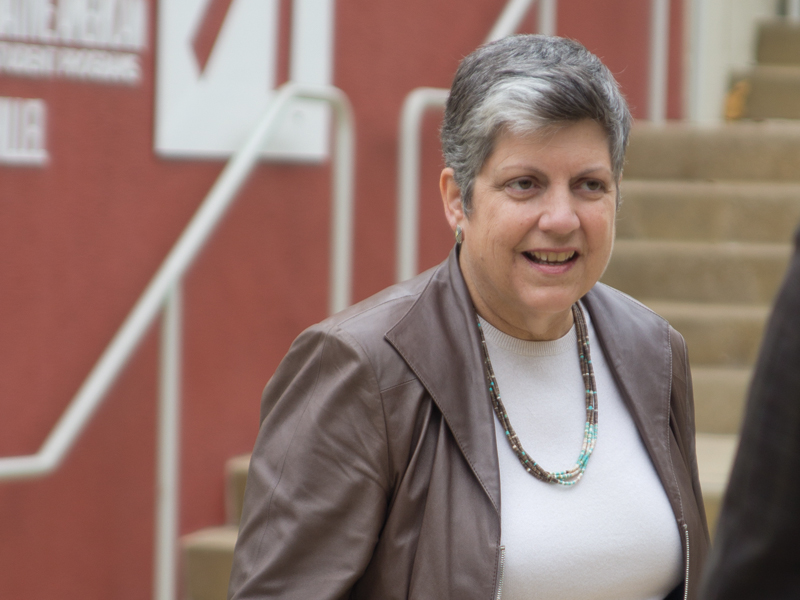
UC President Janet Napolitano announced her intent to freeze tuition for the 2014-15 academic year, as part of a long-term strategy she presented during her first UC Board of Regents meeting, from Nov. 12-14. This would be the third consecutive year of tuition freezes in nearly a decade of state divestment from the 10 UC campuses during poor economic conditions.
In an effort to increase accessibility and affordability, Napolitano also plans to streamline the flow of community college transfer students to the UC, speed the circulation of research ideas and findings throughout the UC system, and reduce the university’s energy consumption to net-zero.
Tuition Freeze
Napolitano urged the California legislature to cooperate with the UC to create an affordable and unvarying tuition policy for students. “This is not a mere timeout, or a one-time holiday. The purpose is to allow the time needed to get (the policy) right,” she said.
With the passage of Proposition 30 and a state buyout of $125 million that prevented tuition increases last year, undergraduates are currently paying the same tuition levels as they were in 2011-2012. UCR undergraduates pay an approximate amount of $14,000 this year in tuition and fees, while undergraduates systemwide pay approximately $13,000. This number varies across UC campuses because it takes into account different student fees unique to each campus, while excluding extraneous fees such as room and board.
Napolitano offered a possible model called cohort tuition, which allows the entering class to have the same tuition for four years, but subsequently increases tuition for the following class of undergraduates.
“Tuition goes right to the heart of accessibility and affordability — two of the university’s guiding stars,” Napolitano said. “We need to figure out, in the real world in which we live, how to bring clarity to and reduce volatility in the tuition-setting process. It’s time for the university to collaboratively come up with another way.”
Half of UC students’ tuition costs are fully covered by financial aid and another 20 percent receive a partial financial aid package from the UC, which amounts to an annual average of $6,500 — slightly more than half of annual UC tuition per student.
Napolitano plans to explore and develop creative strategies for expanding the university’s revenues. This would allow the university more time to come up with a decisive strategy that quells the unpredictable spikes in student fees.
Streamlining the flow of transfer students and research technologies to the UC
Napolitano also addressed the UC’s need to streamline the transfer process for community college students, which would aid in diversifying campus populations while increasing access to potential UC students.
The main challenge, Napolitano identified, would be to accommodate the increasing number of transfer students within limited university capacities and facilities.
Regardless of the challenge, Napolitano recognized that, “many California students begin their higher education at a community college, yet yearn for the opportunity to get a four-year degree.” Thus, there is the need to “make that opportunity more available to all,” she said.
The UC president also called for UC Provost Amy Dorr to start a “strike team,” to offer recommendations for ways to increase UC transfer rates.
California Community Colleges Chancellor Brice Harris applauded Napolitano’s initiative on working with community colleges to enhance transfer rates.
“Our state stands to benefit from increasing numbers of students completing the bachelor’s degree and helping to keep California globally competitive,” said Harris in a press release.
Napolitano emphasized the importance of finding new ways to increase the productivity of research and technology in order to address world issues, such as the scarcity of food, energy sustainability and disease prevention.
“It means removing the barriers that can slow the pace of tech transfer,” she said. “And it means thinking about how we can invest in all elements of technology commercialization: patents, proof-of-concept and early-stage investment in UC startups — everything that can help move our research into the market and into the world.”
Energy efficiency
Finally, the president announced the goal of making the University of California a net-zero energy consumer by 2025. The idea is to produce as much clean energy to replace the energy the university has consumed.
Citing Gov. Jerry Brown’s recent clean energy pact — an agreement between the states of California, Oregon and Washington, in addition to the Canadian province of British Columbia, to reduce greenhouse gases — Napolitano will seek to engage support from students and researchers from an array of professional fields who are committed to sustainability efforts. Her plans on how to proceed with her initiatives are still unclear.
Napolitano recognized that her dynamic policy agenda is not easy to achieve as UC president, drawing parallels between hitting its goals and climbing steep mountains. Nevertheless, she was optimistic with her vision and expressed good faith in the university’s commitment to research and innovation.
“The good news is that research universities like UC are in the business of breaking through barriers,” she said. “That’s why we call them breakthroughs. It is the essence of what research universities do.”
As a concluding remark, she reiterated her commitment to the four goals that she set to better the UC, taking full accountability for the list of items that she introduced.
- Vincent Ta/HIGHLANDER
“If we get tuition right, if we get access for transfers right, if we invest in our own research and change the game on energy consumption, then UC will demonstrate to the nation, and beyond, the fundamental and unique value of a world-class public research university,” Napolitano concluded.








